Publications launched at AIDS 2016
1 August 2016. Related: Conference reports, Other news, World AIDS 21 Durban 2016.
Simon Collins, HIV i-Base
As with all World AIDS Conferences, many organisations used the meeting to launch publications. A selection of these are highlighted below.
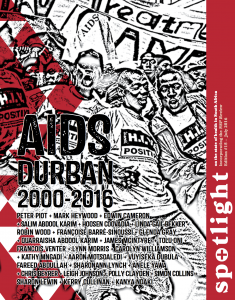 Spotlight: AIDS Durban 2000-2016
Spotlight: AIDS Durban 2000-2016
TAC and Section27
Compulsive reading from some of the sharpest and most inspiring activists involved in the South African HIV struggle report on the historical context of the Durban conference.
HIV positive activists drove the South African government to provide ART – and this activism continues for universal access to treatment in 2016.
This is a joint publication from Treatment Action Campaign and Section27.
Spotlight: A print and online publication monitoring South Africa’s response to TB and HIV, the state of our health systems and the people that use it and keep it going. First edition, July 2016.
http://www.spotlightnsp.co.za/wp-content/uploads/2016/07/000-spotlight-15-web.pdf (PDF)
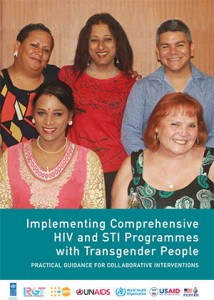 TRANSIT: UNDP report on care for transgender people
TRANSIT: UNDP report on care for transgender people
UNDP
This report from the United Nations Development Programme was launched in a few months before AIDS 2016 but the conference provided one of the first chances to widely distribute this toolkit on transgender issues.
“Implementing comprehensive HIV and STI programmes with transgender people: practical guidance for collaborative interventions” is a resource that was developed by a broad network of trans people, programme managers, researchers and development partners.
Running to almost 200 pages it is written in five main sections.
- Community empowerment. The foundation of the resource, describes how empowerment of trans people is both an intervention in itself, and also essential to effective planning, implementation and monitoring of all aspects of HIV and STI prevention, diagnosis, treatment and care.
- Stigma, discrimination, violence and human rights. The urgent needs of trans people: to be protected from violence, discrimination and other forms of human-rights violation.
- Services. Detailed descriptions of gender-affirming health services and HIV-related and other essential health interventions. These include primary care, cross-sex hormone therapy, surgical procedures and service integration. HIV-related services include condom and lubricant programming, harm reduction services for substance use and safe injection, pre- and post-exposure prophylaxis, voluntary HIV testing, antiretroviral therapy, sexual and reproductive health, and mental and psychosocial health. The chapter also addresses HIV and hormonal therapy.
- Service delivery. Trans-competent clinical approaches, social and behavioural interventions, approaches to HIV prevention, community-led service delivery, safe spaces (drop-in centres), and the use of information and communication technologies.
- Programme management. Practical guidance on planning, starting, scaling up, managing and monitoring both large multi-site programmes and more localised organisations.
https://www.unfpa.org/sites/default/files/pub-pdf/TRANSIT_report_UNFPA.pdf (PDF)
thelancet.com/journals/lanhiv/issue/vol3no7/PIIS2352-3018(16)X0007-0
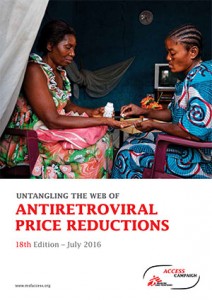 Untangling the web of ARV price reductions
Untangling the web of ARV price reductions
Médecins Sans Frontières (MSF)/Doctors Without Borders
The 18th edition of the MSF HIV drug pricing report is the single most important reference for pricing and access to generic HIV drugs globally.
This update is the clearest report for tracking the importance of generic competition, primarily from India.
Since the last edition, the lowest available price for a WHO-recommended first-line one-pill-a-day ART (tenofovir/emtricitabine/efavirenz) had dropped by 26% from $136 to US$100 per person per year. For second-line ART, the lowest available price has dropped 11% from $322 to $286 (zidovudine/lamivudine + atazanavir/ritonavir).
Newer drugs remain more expensive but are the only options for third-line ART. The lowest annual price for raltegravir + darunavir/ritonavir + etravirine is $1,859, reduced by only 7% from $2,006 in 2014. This is 18 times the price of first-line therapy, and six times the price of second-line combinations.
The report also highlights the growing concern for access to ART in middle-income countries who pay much higher prices due to patents.
MSF. Untangling the web of antiretroviral price reductions (18th edition).
https://www.doctorswithoutborders.org/sites/usa/files/antiretroviral_price_reductions.pdf (PDF)
Making viral load routine
Médecins Sans Frontières (MSF)/ Doctors Without Borders
Based on a survey from ten ART sites and seven viral load testing labs this MSF report aims to share practical lessons from the field with Ministries of Health and implementing partners.
The two-part report covers the strategies required within the clinic (for clinicians, counsellors and patients) and the realities of both setting up and keeping a viral load testing laboratory functional in low-income settings.
It emphasises that national viral load scale up plans must link both programmatic and laboratory planning if viral load tests are to become a routine part of HIV care.
http://www.msfaccess.org/content/report-making-viral-load-routine
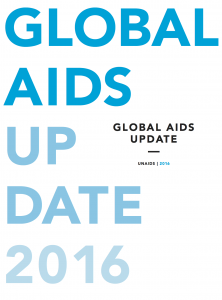 UNAIDS: global AIDS update
UNAIDS: global AIDS update
UNAIDS
Summary 12-page report from UNAIDS on the plans to end AIDS by 2030 and the progress towards the 90:90:90 targets for 2020.
http://www.unaids.org/en/resources/ documents/2016/Global-AIDS-update-2016
http://www.unaids.org/sites/default/files/ media_asset/global-AIDS-update-2016_en.pdf (PDF)
 Implementation science in Africa: JIAS special issue
Implementation science in Africa: JIAS special issue
The Journal of the International AIDS Society launched a special issue on implementation: “Lessons learned and study results from HIVCore, an HIV implementation science initiative”.
HIVCore is a five-year US NIAID-funded project focused on operations and implementation research. This report includes ten articles based on these issues in several African countries
http://jiasociety.org/index.php/jias/issue/view/1482
http://jiasociety.org/index.php/jias/article/download/21261/pdf (PDF)
HIV and related infections in prisoners
The Lancet
An excellent special issue of The Lancet produced for AIDS 2016 includes articles by key researchers on HIV care for prisoners.
Prisoners experience high rates of HIV, TB and viral hepatitis and often have little or no access to HIV treatment, prevention, and care.
As with previous special editions, access to all content is provided free.
http://www.thelancet.com/series/aids-2016
Lancet HIV: focus on prevention
Although the full contents of this AIDS 2016 edition of the Lancet HIV were not free, most of the key articles are open access.
http://www.thelancet.com/journals/lanhiv/issue/vol3no7/PIIS2352-3018(16)X0007-0
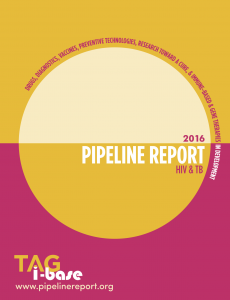 i-Base/TAG pipeline report 2016
i-Base/TAG pipeline report 2016
HIV i-Base and TAG
This annual publication from i-Base and TAG reviews the most advanced research relating to pipeline compounds for treatment, prevention, diagnostics and related strategies for HIV, TB and to a limited extent this year, hepatitis C.
The HIV chapters cover adult and paediatric care, treatment optimisation for global access, prevention advances and research into a cure. The TB chapters cover treatment and prevention.
Over 1000 printed reports and 2000 memory sticks with PDF publications were distributed at AIDS 2016.
https://i-base.info/2016-pipeline-report
https://i-base.info/htb/wp-content/uploads/2016/07/2016-Pipeline-Report.pdf (PDF)

